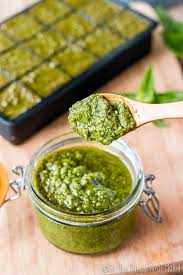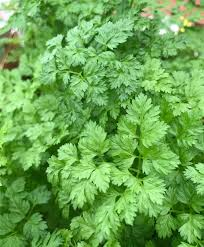
Making pesto
Edible Campus volunteer Isabelle Low writes: Hooray! The hungry months are over; and we are now starting to have to deal with seasonal gluts instead. I have a little veg now (courgettes and lots of salads), but by no means a glut. But my herb garden needs hard picking to keep it under control.
So I’m making lots of different pestos. Although traditional pesto genovese is made with basil, I’m currently more concerned to use up huge quantities of chervil, lovage and mint. A little later on, I’ll be turning my attention to spinach and rocket and parsley and (yes) basil. Even in winter, you can use up a glut of kale this way.
To make pesto, you need a food processor or blender. Even a stick blender will do, although the end product won’t be as smooth. Personally I prefer a bit of texture.
The core ingredients are simple:
- greenery, picked as fresh as possible, washed if necessary and with the thicker stems cut out. Don’t worry about finer stems: much of the flavour is in them
- garlic, chopped fine
- nuts: tradition is to use pine nuts but they are very expensive. In Italy, thrifty housewives use walnuts or hazelnuts or almonds instead. At a pinch, you could even use salted peanuts!
- oil: I do prefer a decent olive oil but sunflower or rapeseed will do.
The whole process takes no more than a few minutes. I like to start by chopping the nuts fine (they are the hardest element so take the longest to process); then add the garlic; then the greenery. That should give you a very thick green crumble. Now trickle in (with motor running on slow if your machine does that) some oil until you have a thick paste. I prefer to keep it very thick at this stage so that I can add a bit of extra oil when I am using it.)
A good trick is to use the mix to fill one or more ice cube trays. Open freeze these until solid then transfer the cubes to a bigger container in the freezer. That way you can add as much or as little as you like when you get round to cooking with them.
The longest part of the whole process is cleaning the blender; and even that is easy if you add some water to the sticky residue and whoosh it for a few seconds. You end up with a great stock that can also be frozen and a blender which is easy to clean.
You will have noticed that I haven’t added any cheese at this stage. My Italian foodie friends never do (they say the mixture stays fresher tasting without). So when you get around to using it, just add some grated parmesan. Or you can use the cheaper grano padana (but what you save in price, you lose in flavour). Or the afore-mentioned thrifty Italian housewives will add whatever remnants of cheese they have that needs used up. Or increasingly I like a good pesto without adding cheese at all – which makes it vegan-friendly of course. Up to you.
A final word of warning: I tend to be a bit casual about labelling what is in my freezer but it is really important to label each pesto version since they will all look alike but taste quite different. Best to know what you are eating….


